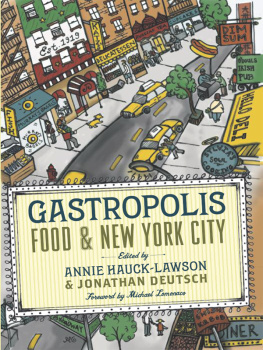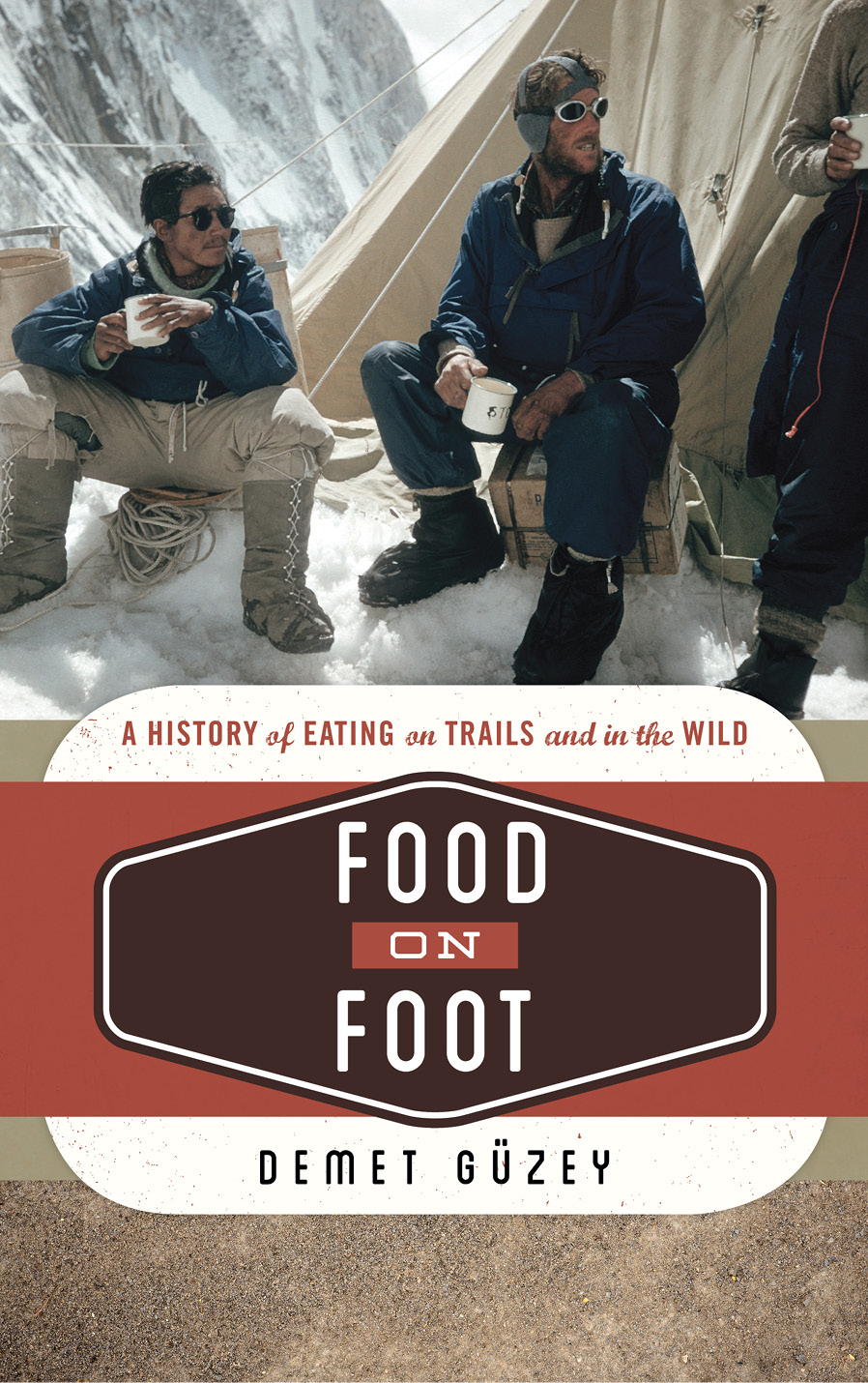Food on Foot
Food on Foot
The Food on the Go Series
Series Editor
Ken Albala, University of the Pacifi
The volumes in this series explore the fascinating ways people eat while getting from one place to another and the adaptations they make in terms of food choices, cutlery and even manners. Whether it be crossing the Atlantic in grand style on a luxury steamship, wedged into an airplane seat with a tiny tray, or driving in your car with a Big Mac in hand and soda in the cup holder, food has adapted in remarkable ways to accommodate our peripatetic habits. Eating on the go may be elegant or fast, but it differs significantly from everyday eating and these books explain why in various cultures across the globe and through history. This is the first series to systematically examine how and why mobility influences our eating habits, for better and worse.
Books in the Series
Food on the Rails: The Golden Era of Railroad Dining , Jeri Quinzio (R&L, 2014)
Food at Sea: Shipboard Cuisine from Ancient to Modern Times , Simon Spalding (R&L, 2014)
Food in the Air and Space: The Surprising History of Food and Drink in the Skies , Richard Foss (R&L, 2014)
Food on Foot: A History of Eating on Trails and in the Wild , Demet Gzey (R&L, 2017)
Food on Foot

A History of Eating on Trails and in the Wild
Demet Gzey
ROWMAN & LITTLEFIELD
Lanham Boulder New York London
Published by Rowman & Littlefield
A wholly owned subsidiary of The Rowman & Littlefield Publishing Group, Inc.
4501 Forbes Boulevard, Suite 200, Lanham, Maryland 20706
www.rowman.com
Unit A, Whitacre Mews, 26-34 Stannary Street, London SE11 4AB
Copyright 2017 by Rowman & Littlefield
All rights reserved . No part of this book may be reproduced in any form or by any electronic or mechanical means, including information storage and retrieval systems, without written permission from the publisher, except by a reviewer who may quote passages in a review.
British Library Cataloguing in Publication Information Available
Library of Congress Cataloging-in-Publication Data
Names: Gzey, Demet, author.
Title: Food on foot : a history of eating on trails or in the wild / Demet Gzey.
Description: Lanham : Rowman & Littlefield, [2017] | Series: Food on the go | Includes bibliographical references and index.
Identifiers: LCCN 2016041844 (print) | LCCN 2016051218 (ebook) | ISBN 9781442255067 (cloth : alk. paper) | ISBN 9781442255074 (Electronic)
Subjects: LCSH: Wild foods. | Food habitsHistory. | Outdoor recreationHistory. | SurvivalHistory.
Classification: LCC TX369 .G89 2017 (print) | LCC TX369 (ebook) | DDC 394.1/209dc23
LC record available at https://lccn.loc.gov/2016041844
 The paper used in this publication meets the minimum requirements of American National Standard for Information SciencesPermanence of Paper for Printed Library Materials, ANSI/NISO Z39.48-1992.
The paper used in this publication meets the minimum requirements of American National Standard for Information SciencesPermanence of Paper for Printed Library Materials, ANSI/NISO Z39.48-1992.
Printed in the United States of America

Contents
Chapter 1:
Chapter 2:
Chapter 3:
Chapter 4:
Chapter 5:
Chapter 6:
Chapter 7:
Chapter 8:

Food on the Go, Series Foreword
How familiar is the lament? No one sits down to eat any more! People just grab something on the street or at the drive through. Thats not a proper meal; its just noshing on the way from one place to another. Food on the move is nothing new. There has always been street food and fast food. People have always eaten in transit. Our tendency to dismiss such meals as quick and convenient but never of any real gastronomic distinction does injustice to the wide variety of foods available to people travelling, and sometimes these meals could be quite elegant indeed. Think of the great caravans trekking across the steppes of Western Asia, parking their camels and setting up tents for a sumptuous feast of dried fruits, nuts, flatbreads and freshly roasted kebabs. Or think of the great age of early air travel when airlines had their own specially designed dishware and served elegant, if seat-tray-sized, meals prepared by trained chefs. Meals served on trains in the nineteenth century were among the most celebrated of their day and of course luxury cruises pride themselves on fine dining as an indispensable feature of the entire experience. Food truck fare, offered to pedestrians, has now become the cutting edge in hip cuisine.
Travelling food need not be grand though. Sometimes it merely supplies sustenance the hikers trail mix or high protein pemmican to sustain the intrepid hunter on the great plains. It can also be pretty rough if we think of the war time C-Rations or hard tack and rum given to sailors in the colonial era. It seems as if some modes of transport have their own repertoire of foods, without which the trip would not be complete. Whats a road trip without chips and junk food? Is there anyone who doesnt miss the little packs of salty peanuts on domestic flights? Travelling food also poses its own unique set of challenges, both for food preparation and consumption. Imagine stoking a fire on a wooden ship! Or flipping an omelet while the train rumbles violently over the tracks. Hand held food, perhaps the way of the future, is the quintessential traveling format, but so too are special styrafoam containers and sporks, not to mention the leather bota, aluminum canteen or plastic water bottle. Traveling food has its own etiquette as well, looser than the dining table, but interestingly quite private, perhaps intentionally in considering the public setting.
When I first thought of this series I dont think I had ever thought through how many foods are specially designed for travel, or how complex and very culturally bound food eaten on trains, planes, cars, bikes, horseback, etc. can be. I will never forget a long train ride I took from Rome to the Tyrolean Alps. A young family sat across from me and they were well stocked with goods. Out came a salami, a loaf of bread, a hunk of cheese, a bottle of wine. They were making a mess, gesticulating wildly, chattering in Italian. It all looked delicious, and they savored every morsel. By the time we approached the German-speaking region, they had neatened themselves up, tidied the area, switched languages and every trace of their Italian repast was gone, and would have been completely unseemly, I think, that far north. That is, people do have explicit gastronomic traditions for travel that are as bound up with nationhood, class, gender and self as any other eating habit. So it is about time we thought of these kinds of meals as a separate genre, and this series I hope will fill the gap in our understanding of why we eat what we do on the move.
Ken Albala, University of the Pacific














 The paper used in this publication meets the minimum requirements of American National Standard for Information SciencesPermanence of Paper for Printed Library Materials, ANSI/NISO Z39.48-1992.
The paper used in this publication meets the minimum requirements of American National Standard for Information SciencesPermanence of Paper for Printed Library Materials, ANSI/NISO Z39.48-1992.